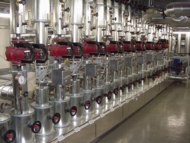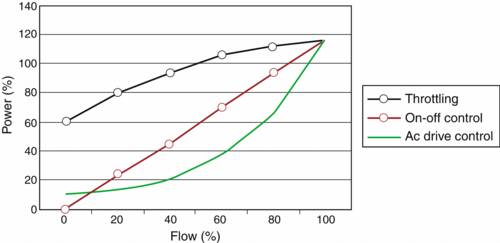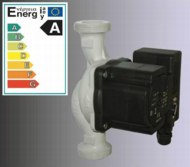The role of pumps in delivering energy savings

Fig. 1:This bank of pumps in a heating system uses variable-speed control to match flow rate to demand.
There is very little to be gain by improving the efficiency of pumps to reduce their energy consumption. Much more can be saved — about half — using speed control and the better design of systems, as John Veness explains.Pumping systems consume 13% of all UK electrical energy, and independent studies have identified the potential to save over a million tonnes a year of carbon emissions a year by better design and operation of pumping systems. This study has led to the Government setting targets to reduce consumption by 6 TWh/a by 2020 [T, Tera, is 10 to thepower 12]. Over the past four years the British Pump Manufacturers’ Association has adopted a proactive position with regard to the reduction of energy consumption in pumps and systems. The BPMA has been working with Future Energy Solutions (now AEA Environmental) to develop the pump-system element of the Government’s market transformation programme. Very nearly half of the energy consumed by pumps is in systems installed in domestic, commercial and public buildings. Its not surprising therefore that this sector is receiving a lot of attention from pump owners, suppliers, system designers and installers. Whilst there is some potential to improve pump design it is recognised that this would yield only on average about 4% saving in energy consumption. System-based measures offer the greatest potential, and over 50% savings may be made. Pumps are used for many purposes in buildings, including boosting water supply pressure boosting, fire protection, heating, ventilation and air conditioning. All of these offer opportunities, but it is in HVAC systems where the biggest savings can be made. These systems require a wide range of flow rates to respond to seasonal, temperature control and different zone requirements. In these systems the pressure required from the pump is mainly determined by the friction loss within the system. The pressure required varies closely with the square of the flow rate, so a small change in flow results in a large reduction in required pressure (Fig. 1) Control of such systems has usually been provided using throttling and balancing valves or on/off control. All these methods are inefficient and waste energy. While throttling reduces the flow, the motor is still running at full speed and works even harder as it has to work against a restriction. By reducing the speed of the motor, a variable-speed drive ensures no more energy than necessary is used to achieve the required flow. A centrifugal pump running at half speed consumes only an eighth of the energy compared to one running at full speed.
 |
Fig. 2: Controlling the speed of pumps to deliver the required flow rate is far more effective at reducing power consumption that throttling and on/off control. |
The most efficient way of controlling flow within these types of systems is the use of electrical variable speed control. Reducing the speed of the pump reduces both flow and pressure, and a 30% reduction in flow can lead to a 60% reduction in energy. Variable-speed drives may be simply fitted to existing motors without the need to change system pipework, although of course throttling valves should be fixed fully open (Fig. 2). When considering retrofitting a variable-speed drive it may also be worth considering upgrading to a high-efficiency motor to achieve a 3 to 5% reduction in running cost. A 90 kW high-efficiency motor could cost £1200 more to buy than the standard model but will save £12 000 during a 10-year service life. It is estimated that savings of £74 million have already been made by using variable-speed drives and high-efficiency motors. Pump manufacturers have brought together improvements in pump design, variable-speed control and high-efficiency motor technology into the latest circulators now available to the building-services industry. Since its introduction in 1995, energy labelling for domestic appliances has grown, with more products being added every year. Domestic circulators have now joined the scheme on a voluntary basis. A number of manufacturers that, between them, account for about 80% percent of domestic-circulator sales in Europe, have committed to add the energy label to all their relevant product packaging.
 |
Fig. 3: Domestic circulators (up to 4 kW) have joined the Energy-Labelling Scheme on a voluntary basis, and their benefits are being made available to larger pumps. |
These new-design circulators, although targeted initially at the domestic market, are available with all these beneficial features up to 4 kW — bringing them into a number of applications in public and commercial buildings. Continued development will see these high-efficiency designs increasing in size to cover all major applications in buildings, which will make an important contribution to reducing a building’s energy footprint (Fig. 3). The BPMA will continue to work with its members to improve awareness of the opportunities to reduce the energy consumption of pump systems. This work has already led the development of three energy-savings guide for Europump, which are used worldwide. These guides cover life-cycle-cost analysis, system design and variable-speed pumping and are available from the BPMA bookshop. In 2005, BPMA members financially supported the commissioning of an ‘options for action’ report by SUSTAIN, which led in 2006 to the formation of a focused BPMA energy group that developed the BPMA’s programme for better pumping practices to turn its strategy into deliverables and the setting up of a website specialising in the energy performance of pumps* as a resource to help users to buy and operate more efficient pumps and systems.
John Veness is market-transformation consultant with the British Pump Manufacturers’ Association.
Related links:











